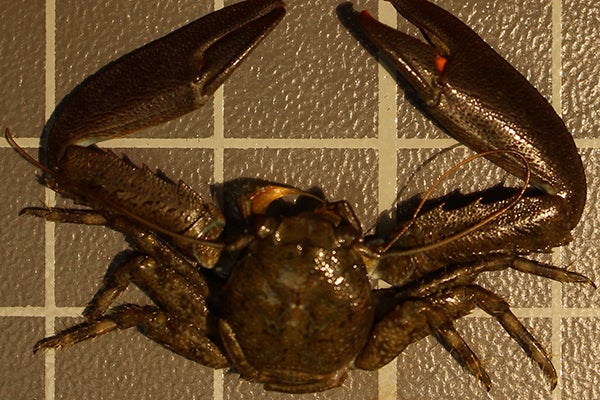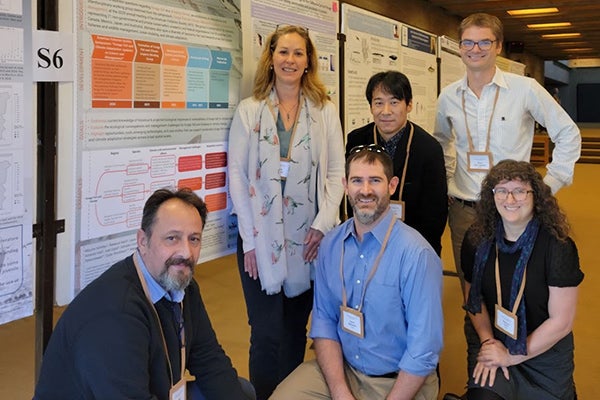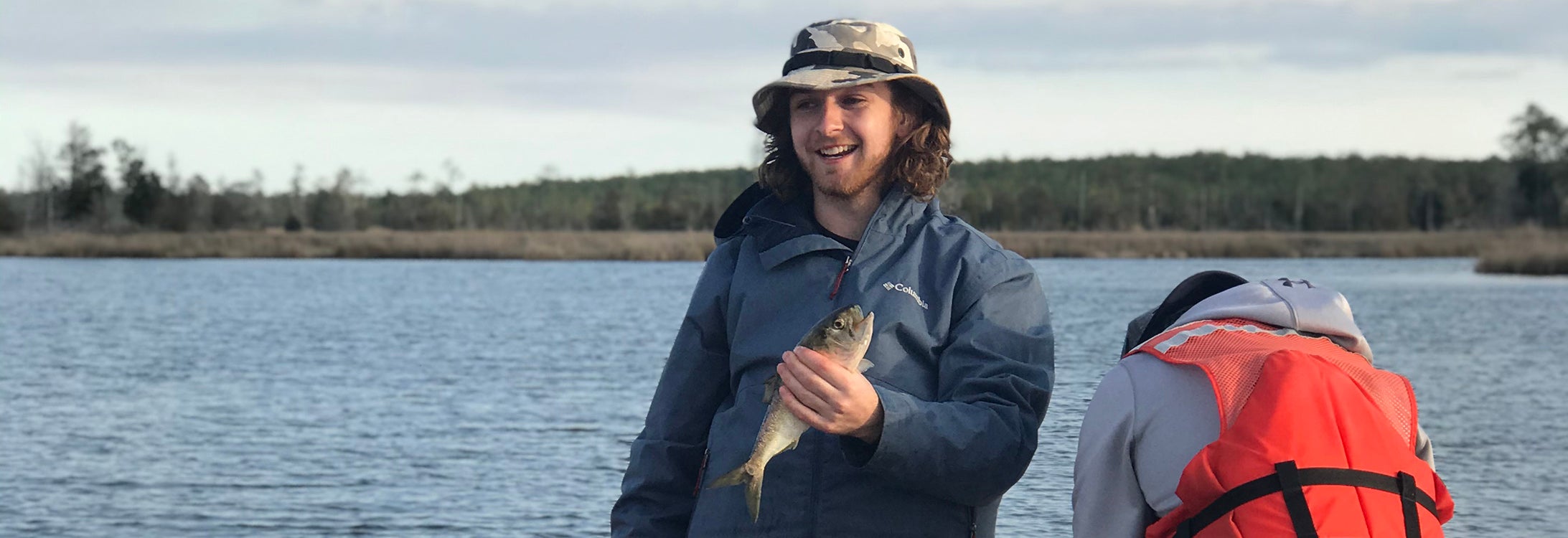AQUATIC ENVIRONMENTAL CHANGES
Impact of species introduction, invasion and changing fish populations
East Carolina University faculty and students in the Thomas Harriot College of Arts and Sciences are researching range-expanding marine species and changing fish populations, as well as the effects climate may have on these groups and other environmental now and into the future.
April Blakeslee, associate professor of biology, serves as the United States representative to the International Council for the Exploration of the Sea (ICES) working group on the Introduction and Transfer of Marine Organisms (ITMO). Blakeslee has held the position, which is appointed by the National Oceanic and Atmospheric Administration (NOAA), since 2018 and said it is an honor to be selected as the U.S. representative.

Climate change recently has driven the green porcelain crab up along the North Carolina coast, the farthest north this crab species has been reported. It is a representative of several climate migrant species that have been collectively referred to as the “Caribbean creep.”
Rebecca Asch, assistant professor of biology, is contributing to an ICES working group examining the management and ecology of small pelagic fish — fish that live in the open ocean in the upper water column. The Small Pelagic Fish working group is operating in conjunction with the North Pacific Marine Science Organization (PICES). Asch is working with national and international collaborators on a paper describing how climate change effects on forage fish should be incorporated into management.
Species introductions and invasions
Through her ICES appointment, Blakeslee compiles information and develops reports on the status of new species introductions and significant expansions of marine organisms to the Gulf of Mexico and the U.S. Atlantic Coast. She reports on current and new regulations regarding the U.S. response to marine species invasions. She is also a contributing member of the ICES Working Group on Ballast and Other Ship Vectors, which she said is important to the applied nature of her work on introduced species.
In March, Blakeslee presented the U.S. national report to the international group of ICES member nations in Athens, Greece. The international working group is represented by the United States, Canada, Iceland, the United Kingdom, France, Spain, Portugal, the Netherlands, Germany, Denmark, Sweden, Norway, Finland, Poland, Israel, Italy, and Greece.
At the meeting, Blakeslee contributed to a report on coastal species responses to climate change, presenting findings from a project she is leading with Rachel Gittman, ECU assistant professor of biology, concerning a recent climate-driven expansion of the green porcelain crab (Petrolisthes armatus) to the North Carolina coast. Gittman and Blakeslee are co-authoring a paper that provides the first report of this species in the region, representing the northernmost expansion of its population range in the southeast U.S. Their porcelain crab project involves multiple students in both the Blakeslee and Gittman labs, including graduate students Carter Stancil, Grace Loonam, Megan Geesin and undergraduate student Chloe Manning-Moore.
“This species of crab is representative of several climate migrant species that have been collectively referred to as the ‘Caribbean creep,’ species creeping their way up the coastline from tropical and subtropical waters into temperate regions as a result of rising temperatures,” Blakeslee said.
According to Blakeslee, species invasions are one of the top threats to marine biodiversity.
“Invasive species often leave behind their natural enemies, and thus, when they invade new communities, native species may not recognize them as predators or prey,” she said. “In turn, these invading species may be able to outcompete natives. It is vital to recognize species invasions at early stages to determine what impacts they may have on their invaded communities.”
Gittman and Blakeslee have been surveying coastal regions of North Carolina over the past six years. Due to their comprehensive examination of the local biodiversity, they were able to capture the species invasion of the green porcelain crab when it first arrived.
“This will allow us to document potential changes to coastal communities over time as the species establishes and spreads through the region,” Blakeslee said.
“The invasive porcelain crabs were so abundant in one of our sampling locations that when we finally encountered our first native, we were not sure which species of porcelain crabs they belonged to,” said Stancil, a student in the interdisciplinary doctoral program in biology, biomedicine and chemistry (IDPBBC) who is helping with the research. “After confirming our finding with genetic testing, we were able to identify only 15 native crabs out of the 632 we collected (0.024%).”
Species invasions can disrupt or change ecosystem function, and there are numerous examples of marine invaders that have caused serious population declines of native species.
“We do not yet know what impact the invasion of the green porcelain crab may have on coastal communities of North Carolina, but studies from Georgia and South Carolina have shown major population explosions of the species and impacts on local communities. We intend to continue monitoring and designing experiments to explore this question in our region,” Blakeslee said.
Changing fish populations
Asch, who became interested in small pelagic fish research while performing lab work during her doctoral program, attended a symposium organized by the ICES and PICES Small Pelagic Fish working group in Lisbon, Portugal, in November 2022.

Asch, right, at the Small Pelagic Fish Symposium. (Photo by Michelle Staudinger)
Globally, small pelagic fish — which include Atlantic menhaden, that are local to North Carolina’s coast, and various forage fish like sardines and anchovies — make up the largest marine capture fisheries. Asch said that out of the world’s largest fish stocks, six out of the top 10 fish captured are small or medium-sized pelagic fish. She said they are important for direct human consumption, but they are also used to produce nutritional supplements that contain omega-3 fatty acids and make feed for livestock and fishmeal for aquaculture.
Farisal Bagsit, a graduate of ECU’s Coastal Resource Management doctoral program, renamed the Integrated Coastal Sciences doctoral program, examined small pelagic fish in the Philippines during her time at ECU. She studied a seasonal fishery closure in the Philippines that protects the fish from being captured three months out of the year.
According to Bagsit, seasonal fishing closures can create hardships on the community that relies on the fish for its livelihood. She studied this impact on the community as well as the effects on the fish population. At the symposium in Portugal, Bagsit presented a chapter of her dissertation research, sharing her findings on the effectiveness of the seasonal fishery closure in the Visayan Sea from the standpoints of fishery-dependent communities and fishery management.
“Small pelagic fish play large roles in several ecosystems,” Asch said. “They link the base of the food web with upper trophic levels and top predators. They can be important prey for larger fish, squid, seabirds and marine mammals.”
According to Asch, pelagic fish are also among the most sensitive fish to climate, and people have proposed that fluctuations in their numbers may even be an indication of climate variations.
“For more than 50 years, we have been trying to understand the mechanism for this change, whether it’s purely temperature, changes in marine food webs or oxygenation of the habitats where the fish live due to climate,” she said.
To understand some of these changes, Asch is coordinating research activity associated with the ICES and PICES Small Pelagic Fish working group, examining where these fish occur, when they reproduce, and any changes to location, seasonality and breeding habits from the past in relation to climate change.
She said we need to understand what is driving the changes to be able to project what may happen in the future and how it may have an impact on marine food webs.
